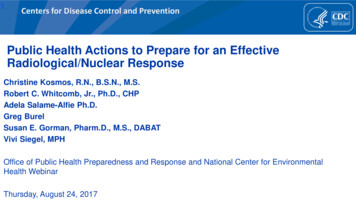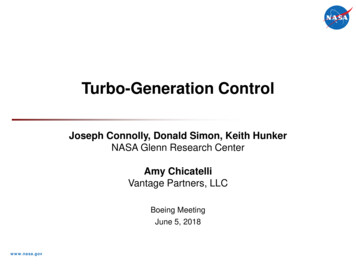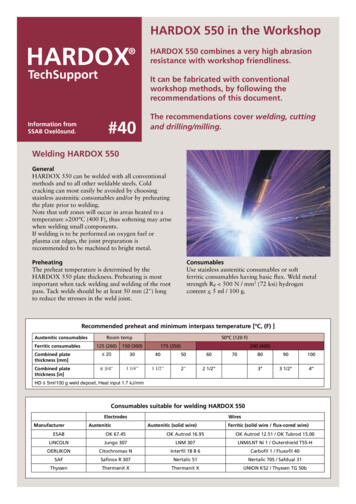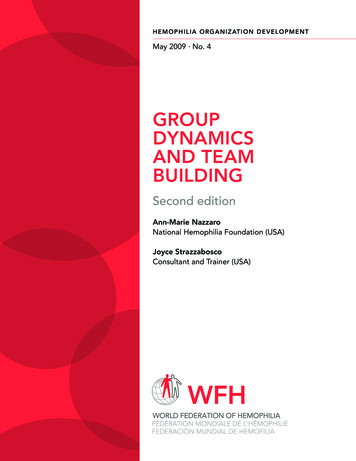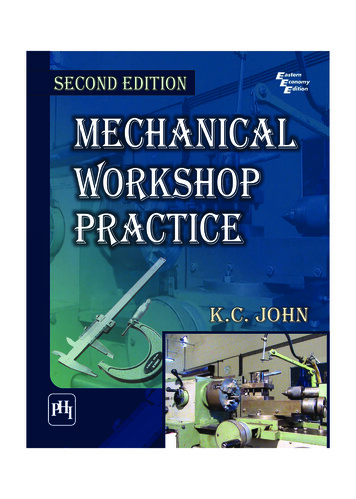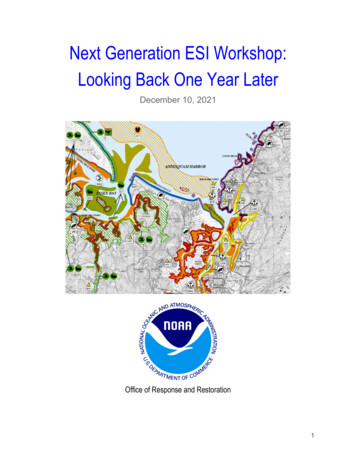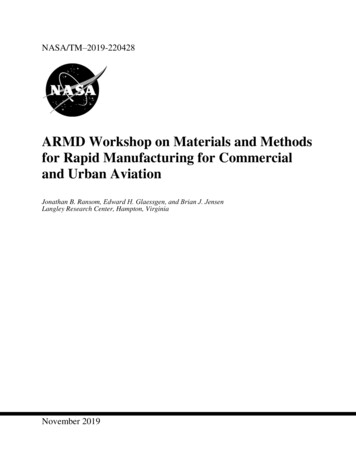
Transcription
NASA/TM–2019-220428ARMD Workshop on Materials and Methodsfor Rapid Manufacturing for Commercialand Urban AviationJonathan B. Ransom, Edward H. Glaessgen, and Brian J. JensenLangley Research Center, Hampton, VirginiaNovember 2019
NASA STI Program . . . in ProfileSince its founding, NASA has been dedicated to theadvancement of aeronautics and space science. TheNASA scientific and technical information (STI)program plays a key part in helping NASA maintainthis important role. CONFERENCE PUBLICATION.Collected papers from scientific and technicalconferences, symposia, seminars, or othermeetings sponsored orco-sponsored by NASA.The NASA STI program operates under the auspicesof the Agency Chief Information Officer. It collects,organizes, provides for archiving, and disseminatesNASA’s STI. The NASA STI program provides accessto the NTRS Registered and its public interface, theNASA Technical Reports Server, thus providing oneof the largest collections of aeronautical and spacescience STI in the world. Results are published in bothnon-NASA channels and by NASA in the NASA STIReport Series, which includes the following reporttypes: SPECIAL PUBLICATION. Scientific,technical, or historical information from NASAprograms, projects, and missions, oftenconcerned with subjects having substantialpublic interest. TECHNICAL TRANSLATION.English-language translations of foreignscientific and technical material pertinent toNASA’s mission. TECHNICAL PUBLICATION. Reports ofcompleted research or a major significant phase ofresearch that present the results of NASAPrograms and include extensive data or theoreticalanalysis. Includes compilations of significantscientific and technical data and informationdeemed to be of continuing reference value.NASA counter-part of peer-reviewed formalprofessional papers but has less stringentlimitations on manuscript length and extent ofgraphic presentations.TECHNICAL MEMORANDUM.Scientific and technical findings that arepreliminary or of specialized interest,e.g., quick release reports, workingpapers, and bibliographies that contain minimalannotation. Does not contain extensive analysis.CONTRACTOR REPORT. Scientific andtechnical findings by NASA-sponsoredcontractors and grantees.Specialized services also include organizingand publishing research results, distributingspecialized research announcements and feeds,providing information desk and personal searchsupport, and enabling data exchange services.For more information about the NASA STI program,see the following: Access the NASA STI program home page athttp://www.sti.nasa.gov E-mail your question to help@sti.nasa.gov Phone the NASA STI Information Desk at757-864-9658 Write to:NASA STI Information DeskMail Stop 148NASA Langley Research CenterHampton, VA 23681-2199
NASA/TM–2019-220428ARMD Workshop on Materials and Methodsfor Rapid Manufacturing for Commercialand Urban AviationJonathan B. Ransom, Edward H. Glaessgen, and Brian J. JensenLangley Research Center, Hampton, VirginiaNational Aeronautics andSpace AdministrationLangley Research CenterHampton, Virginia 23681-2199November 2019
AcknowledgmentsThe authors wish to thank all of the organizers, session chairs, speakers, administrative staff andother participants who made this workshop possible. Special thanks to John Cavolowsky from theNASA Aeronautics Research Mission Directorate for sponsoring the workshop and George Finellifrom NASA Langley’s Aeronautics Research Directorate for originally envisioning the workshopand its impact on NASA’s structures and materials research.The use of trademarks or names of manufacturers in this report is for accurate reporting and does notconstitute an official endorsement, either expressed or implied, of such products or manufacturers by theNational Aeronautics and Space Administration.Available from:NASA STI Program / Mail Stop 148NASA Langley Research CenterHampton, VA 23681-2199Fax: 757-864-6500
Executive SummaryThis report is based on the outcomes of a NASA Aeronautics Research Mission Directorate(ARMD)-sponsored workshop held in Tysons Corner, VA, on November 14-15, 2018. Theworkshop, Materials and Methods for Rapid Manufacturing for Commercial and UrbanAviation Workshop, was focused on identifying and assessing the state of technology areasrelevant to rapid/advanced manufacturing, understanding critical technology gaps andidentifying high-priority investment areas for NASA. One hundred twenty-twoparticipants attended, including materials and manufacturing professionals, originalequipment manufacturers, material suppliers, researchers, government agencies andacademia.The workshop was inspired by several related factors, including the growing worldwidedemand for personal and business travel. To meet this growing demand, commercialaircraft manufacturers need to double production rates within the next 20 years while theemerging urban air mobility (UAM) manufacturers are developing vehicles for passengerand package delivery, requiring high efficiencies while still meeting strict regulatorystructures and materials performance requirements similar to those of commercial aviation.If the aviation industry is to meet production needs at per unit costs and factory floor spacethat are equivalent or less than today’s costs and floor space requirements, the advancedmanufacturing technologies being developed will require corresponding advances inmaterials, processing and certification technologies.The purpose of the workshop was to obtain information from subject matter experts on thetechnical challenges and the high-payoff technical focus areas that can accelerate theimplementation of rapid manufacturing methods by the aviation industry. The workshopfocused on understanding emerging and envisioned developments in advancedmanufacturing; design and development of materials that are optimized for specificmanufacturing approaches; the unique design possibilities associated with advancedmanufacturing; computational materials simulation of material processing andperformance; and development of the future qualification, certification and sustainmenttechnologies that are needed to ensure safety throughout the vehicle’s lifecycle.The workshop began with a series of plenary presentations by leaders in the field ofstructures and materials, followed by concurrent symposia focused on forecasting thefuture of various technologies related to rapid manufacturing of metallic materials andpolymeric matrix composites, referred to herein as composites. The metals symposiumwas organized into four inter-related sessions that included approximately 50representatives from government, academia, and industry consisting of material producers,manufacturers and original equipment manufacturers (OEMs) focused on futuremanufacturing approaches, design and development of materials for those manufacturingmethods, design approaches that exploit emerging rapid manufacturing, and relatedcapabilities for qualification and certification. Similarly, the composites symposium wasorganized into five inter-related sessions that included approximately 70 representativesfrom government, academia, and industry consisting of material producers, manufacturers6
and OEMs focused on rapid manufacturing of thermoset resin-based composites, ites,in-processmonitoring/nondestructive evaluation (NDE) technologies, process modeling andsimulation of advanced manufacturing, composite materials testing requirements followedby a wrap-up discussion.Shortly after the workshop, questionnaires were sent to representative workshopparticipants from the aerospace industry with requests to rank the importance of a series ofpotential investment areas that were identified during the workshop. Areas surveyed formetals included manufacturing, certification, material and structural design, nondestructive evaluation, in-situ monitoring and development of a digital thread for metals.Areas surveyed for composites included unitized structures, thermoset and thermoplasticmaterial development, non-destructive evaluation and in-situ monitoring, processmodeling, testing and cross-cutting technologies, such as adhesive bonding. Responseswere received and subsequently collated by the workshop organizers. Outcomes from theworkshop and subsequent questionnaires are being used as guidance for NASAinvestments in this important technology area.The following technologies were identified as the most promising and high impactapproaches to meet the needs of future aircraft production rate and were included in theOEM survey of potential investment areas. This information will be used to advise seniorNASA management about potential areas for future investment.Potential Investment Areas for Metals Objectively evaluate emerging metals manufacturing methods for their efficacy andpotential impact as a means of rapid manufacturing of flight certified aerospacestructures. Develop computational materials-based capabilities to support qualification andcertification of the most viable rapid manufacturing methodologies to enable their usein production environments. Develop capabilities for design and optimization of materials and structures forrapid manufacturing including materials that are designed to be compatible with rapidmanufacturing processes, optimized structures that exploit new and emergingmanufacturing capabilities and structural systems that integrate both technologies. Develop improved capabilities for NDE and in-situ monitoring that are compatiblewith computational materials-based certification. Develop a comprehensive physics-based/ machine learning-informed computationalframework (digital thread) for processing, materials, performance and life.Potential Investment Areas for Composites Design and analyze unitized and bonded structural concepts (low partcount/reduced assembly/minimal mechanical fastening) optimized for rapidmanufacturing methods.7
Develop fast curing thermoset (TS) resins tailored for out-of-autoclave (OOA)processes including automated fiber placement (AFP) w/vacuum bag only (VBO)curing and resin infusion with VBO curing. Develop in-situ consolidation of continuous carbon fiber thermoplastic (TP) matrixresins by defining relationship of TP tape quality requirements and process parameteroptimization for quality part production. Evaluate thermoforming of flat, continuousfiber panels to wing skin curvatures. Develop advanced in-process monitoring and real-time nondestructive inspection(fiber placement/FOD/autonomous defect recognition) and cure monitoring ofmaterial state (chemistry required for mechanical properties) methodologies. Develop robust process modeling and simulation technologies that can be used topredict defects and material properties for varying process parameters. Develop advanced test methodologies for lower cost/rapid certification of newmaterials/processing methods and model development validation. Develop high throughput cross-cutting technologies, including a rapid surfacetreatment process with integrated surface analysis to measure residual contaminationfor adhesive bonding which will minimize drilling and mechanical fastening.8
AbstractThis report documents the goals, organization and outcomes of the NASA AeronauticsResearch Mission Directorate’s (ARMD) Materials and Methods for Rapid Manufacturingfor Commercial and Urban Aviation Workshop. The workshop began with a series ofplenary presentations by leaders in the field of structures and materials, followed byconcurrent symposia focused on forecasting the future of various technologies related torapid manufacturing of metallic materials and polymeric matrix composites, referred toherein as composites. Shortly after the workshop, questionnaires were sent to keyworkshop participants from the aerospace industry with requests to rank the importance ofa series of potential investment areas identified during the workshop. Outcomes from theworkshop and subsequent questionnaires are being used as guidance for NASAinvestments in this important technology area.1. IntroductionThis report is based on the outcomes of a workshop held in Tysons Corner, VA, onNovember 14-15, 2018. The workshop, Materials and Methods for Rapid Manufacturingfor Commercial and Urban Aviation Workshop, was focused on identifying and assessingthe state of technology areas relevant to rapid/advanced manufacturing, understandingcritical technology gaps and identifying high-priority investment areas for NASA. Onehundred twenty-two participants attended, including materials and manufacturingprofessionals, original equipment manufacturers (OEMs), material suppliers, researchers,government agencies and academia.The workshop was inspired by several related factors, including the growing worldwidedemand for personal and business travel. To meet this growing demand, commercialaircraft manufacturers need to double production rates within the next 20 years while theemerging urban air mobility (UAM) manufacturers are developing vehicles for passengerand package delivery, requiring high efficiencies while still meeting strict regulatorystructures and materials performance requirements similar to those of commercial aviation.If the aviation industry is to meet production needs at per unit costs and factory floor spacethat are equivalent or less than today’s costs and floor space requirements, the advancedmanufacturing technologies being developed will require corresponding advances inmaterials, processing and certification technologies.The purpose of the workshop was to obtain information from subject matter experts on thetechnical challenges and the high-payoff technical focus areas that can accelerate theimplementation of rapid manufacturing methods by the aviation industry. The workshopfocused on understanding emerging and envisioned developments in advancedmanufacturing; design and development of materials that are optimized for specificmanufacturing approaches; the unique design possibilities associated with advancedmanufacturing; computational simulation of material processing and performance; and9
development of the future qualification, certification and sustainment technologies that areneeded to ensure safety throughout the vehicle’s lifecycle.The workshop was the beginning of a collaborative transformation by NASA, industry,academia and other government agencies to better understand production and certificationchallenges while building and strengthening the enduring relationships needed to keepNASA at the forefront of capability development. The event was sponsored by JohnCavolowsky, director of the Transformative Aeronautics Concepts Program (TACP) in theNASA Aeronautics Research Mission Directorate and hosted by George Finelli, directorof NASA Langley Research Center’s (LaRC) Aeronautics Research Directorate. Otherkey personnel included members of the LaRC planning committee, including JonathanRansom (General Chair), Michelle Ferebee (General Co-Chair), Ed Glaessgen (TechnicalProgram Chair), Brian Jensen (Technical Program Chair), Andrea McAlister (LogisticsCoordinator) and the NASA Inter-Center Planning Team, including Sean Swei (AmesResearch Center), Tim Risch (Armstrong Flight Research Center), James Zakrajsek (GlennResearch Center (GRC)) and Joyce Dever (GRC).First, the workshop topic areas and a summary of observations from the workshop arebriefly described. Next, a description of the two symposia, the Metals Symposium and theComposites Symposium, upon which the workshop was organized is given. The surveyresults of workshop-identified potential investment areas are discussed. Finally, a summaryof the workshop is provided. For completeness, Appendix A is provided that contains acomplete list of symposia session presentation titles and presenters.Since the requirements of the metals and composites communities differ slightly, theorganization of the corresponding workshop discussions also differed. Hence, there is someminor variability in the format of the Metals and Composites sections in this document.Although the certification process contains a regulatory component, the terms certificationand qualification were used interchangeably during the workshop discussions. Hence, theyare used interchangeably throughout this document.2. Topic Areas and Summary ObservationsThis section briefly outlines the topics considered during the plenary, metals andcomposites symposia as well as some summary observations about the future of aircraftmaterials, design, certification and manufacturing including NASA’s potential role. Notethat throughout this report, composites refers to polymer matrix composites (PMC).Plenary speakers representing the Federal Aviation Administration (FAA), NASA andaircraft manufacturers presented their views of the future of materials, manufacturing andqualification. Summary notes are given in Table 1.10
Table 1: Plenary SpeakersOrganizationSpeakerSummary NotesFederal Aviation Administration Perspective on Rapid ManufacturingMichael Gorelik - Chief The focus of the presentation was on rapid qualification, a largeScientific and Technical Advisorpart of the material development cycle.for Fatigue and Damage FAA plans to proactively address emerging safety risks includingToleranceestablishment of a new organizational structure to supportLarry Ilcewicz - Chief Scientificemerging innovations.and Technical Advisor for FAA’s 14CFR Part 25 regulations for Materials – fundamentalAdvanced Composite Materialsbased on experience and test – no mention of models yet - “testFederal Aviation Administrationarticle should be full scale.” PMP model – process, microstructure, properties. Damagetolerance is considered by Dr. Gorelik to be a model-friendlydomain; however, there are few current examples of certificationby analysis. Southwest Research Institute’s Darwin code may be a platformthat can deal with effect of defects. There is no regulatory oversight of material development ormaterial qualification; oversight starts at product qualification. Another topic of interest was process parameter control toproduce known microstructure which defines properties. Metallic additive manufacturing is good case to work modelbased qualification. No FAA safety critical part certified yet, but this could happenwithin a year. Need more focus to connect microstructure to properties. New technologies are not aligned with a specific product line, butcross many; the new FAA organization helps deal with that. Design includes materials and manufacturing. Integrated product development, co-located throughdevelopment effort, is essential. A total certification direct operating costs savings of 5-8% ispossible with composites. Produce parts at scale when implementing new rapidmanufacturing processes.NASA’s Manufacturing Development Activities and CapabilitiesRichard Russell - Technical Presentation provided an overview of NASA materialsFellow for Materials, NASAprocessing/manufacturing capabilities.Engineering and Safety Center Focus of the effort is toward advanced manufacturing technologyNational Aeronautics and Spaceand certification requirements for space structures, notAdministrationspecifically related to rapid manufacturing technologies.Advanced Composites and RateGerould Young - Senior Director Design and production are intertwined and cannot be separated.Advanced Manufacturing & View of requirements dictates how structural design is optimized.Materials Product Development For composites, performance other than weight savings isBoeing Commercial Airplanesimportant, including fatigue, inspectability, etc. Production of 50 – 60 million pounds of composites (Airbus andBoeing) in the 2015 timeframe.11
Doubling the amount of composite aircraft structure used by 2030. Some topics of interest to Boeing include thermoplastics, fastcuring resins, thermoforming, high stiffness fibers, stamping,over-molding, reduction of composite processing time (heat/cool,cure, bagging), laydown rates, tooling, forming, painting, sealing,cladding, drilling, fastening, shimming, quality assurance,nondestructive inspection and system installation.Rapid Manufacturing for Aviation: a DOD OEM PerspectiveRichard Barto - Senior Manager Doing nothing is the greatest risk; need to change the way thatof the Lockheed Martinwe certify; need to embrace new manufacturing technologies,Advanced Technology Labsimprove design methodologies and rapid introduction of newLockheed Martin Corporationmaterials. Opportunities include leveraging probabilistic and multiscalemodels. The most promising emerging manufacturing technologies are:out-of-autoclave and resin transfer molding for polymer matrixcomposites, thermoplastic automated fiber placement anddispersion of large filament count carbon fiber tows.Prototype and Production ParadigmsGlenn Isbell, Jr. - Vice President, New technology unlocks innovation.Rapid Prototyping & 4 frameworks are colliding – operations, certification,Manufacturing Innovationmanufacturing, and technology.Bell Digital fabric needed in the design process. Considering all of the information and digital advances, productdevelopment times have gotten slower. Interactive design and virtual validation, enterprise digital mockup (EDMU) is desired.Development of Next Generation Aerostructures and Production SystemsEric Hein - Senior Director Spirit is a global company with 15,000 employees that suppliesResearch and Technology,components to both Boeing and Airbus.Spirit Aerosystems, Inc They focus on cost and need meaningful investment in productdesign that rapidly spans low Technology Readiness Level (TRL) tohigh TRL. Key challenges include advanced architectures, system focusedproduct development, material system optimization,development of ultra-competitive composite airframe structureand lean metallic structures, increased buy-to-fly ratio.An Urban Air Mobility Vehicle Developer PerspectivesJoe Brennen - Manufacturing Joby is developing an all-electric vertical take-off and landingLead(VTOL) vehicle with a 100-150 mile range for multiple (handful)Joby Aviationoccupants; expecting a “large” market. Technologies of interest include additive metallic materialsmanufacturing, rapid (30 minute) cycle times for parts, snapcuring, injection molding, weldable thermoplastics and lightningstrike mitigation. Energy density of current batteries motivates structuralperformance that is at least as good as current aircraft structures.12
Concurrent symposia focused on forecasting the future of various technologies related torapid manufacturing of metallic materials and composites followed the plenary session.Topic areas and specific sessions for the workshop are presented below.2.1. Topic AreasSession Topic Areas included: Manufacturing/processing methods Materials designed/developed for specific manufacturing/processing methods Design for specific manufacturing/processing Certification for materials, manufacturing/processing and applicationThe specific Sessions for each day of the metals and composites symposia included:Day 1 Metals: Manufacturing and Materials - Manufacturing/Processing Methods Metals: Manufacturing and Materials - Design/Development of Materials for SpecificManufacturing Methods Composites: Advanced Manufacturing Methods - Thermosets Composites: In-process Monitoring and Nondestructive EvaluationDay 2 Metals: Component Design and Certification - Component Design/Development thatExploits Manufacturing/Processing Methods Metals: Component Design and Certification - Certification for Materials,Manufacturing/Processing and Application Composites: Advanced Manufacturing Methods – Thermoplastics Composites: Process Modeling and Simulation of Advanced Manufacturing Composites: Panel Session on Testing Requirements for Advanced/RapidManufacturing Processes2.2. High-Level ObservationsThe workshop resulted in numerous observations that may inform NASA decision makingat various levels. While specific observations and recommendations from the workshopare included in the following sections of this report, several summary observations aregiven here:Future Aircraft Materials, Design, Certification and Manufacturing Future aircraft will be heterogeneous with a combination of metals and compositesthat are manufactured using a myriad of approaches. Future production rates require improvements and streamlined relationships in aircraftdesign, materials, certification and manufacturing methodologies.13
Design, certification and manufacturing are inseparable and have to be considered as aunit. The commercial and urban aviation markets have similar challenges. While the rateof production and manufacturing approach is different, neither market can sacrificestructural performance to achieve faster production rates. Rapid manufacturing-related technology development is required as a national asset;manufacturing approaches and forms will evolve significantly during the next 20years. The materials and methods identified for rapid manufacturing are broadly applicableto both the commercial and urban aviation markets. However, the specific materialsand manufacturing needs for urban aviation are evolving as these vehicles continue tobe defined whereas the needs are well known for the commercial aviation market. Maturity of required capabilities (manufacturing through certification) for newmetallic forms lags that for composites; simulations are performed at different lengthscales for metals and composites. Multi-scale understanding of metals and compositesis critical for rapid insertion of emerging materials/process methods.NASA’s Role NASA must understand key steps (sensitivities) in the specific manufacturing processto ensure that NASA investment is high payoff. NASA should invest in advanced materials and foundational methods (experimentaland simulation) that are broadly applicable. NASA should focus on providing well-validated modeling tools to the community. NASA must strengthen its ability to transition from fundamental research toengineering and manufacturing capabilities; strengthen ties with academia and withindustry, increase workforce training, internships and co-ops.3. Metals SymposiumThis section briefly outlines the topics considered during the four sessions of the metalssymposium as listed in Appendix A1 (i.e., Manufacturing/Processing Methods,Design/Development of Materials for Specific Manufacturing Methods, ComponentDesign/Development that Exploits Manufacturing/Processing Methods, and Certificationfor Materials, Manufacturing/Processing and Application). The Metals Symposium wasorganized into four inter-related sessions that included approximately 50 representativesfrom government (NASA, Department of Energy (DoE), National Institute of Standardsand Technology (NIST), FAA, Department of Defense (DoD)), academia, and industryconsisting of material producers, manufacturers and OEMs.Several pervasiveobservations, comments and themes were repeated throughout the four metals-relatedsessions. These included: Metals use continues but their forms looking out to 2040 are not well defined. Manufacturing approaches will evolve significantly during the next 20 years.14
NASA should invest in foundational capabilities that are broadly applicable; providewell-validated modeling tools. Rapid manufacturing means more than just faster fabrication (machine speed). The entire design, manufacturing, certification cycle must be considered. Ex. Time to field the GE Aviation Leading Edge Aviation Propulsion (LEAP)engine additively manufactured nozzle. Inter-relationship between design, material, manufacturing, certification. True for composites also true for new approaches for manufacturing metallicmaterials. As analysis capability has increased, it has slowed product development time. How to reverse this trend? Design materials specifically for new advanced manufacturing methods rather thancontinuing to use legacy materials. Move toward designs that exploit advanced manufacturing. Understand key process parameters as a function of the production hardware. Need more communication between manufacturing, modeling and simulationcommunities.In the remainder of this Section, an overview of the respective sessions in the MetalsSymposium is given and the discussion topics relevant to the sessions are outlined. Basedon the session presentations and the ensuing discussions among the participants, thefollowing questions are addressed What are the most important factors or requirements that drive technology decisions? What are the biggest technology gaps? What are the barriers to adoption of newmanufacturing processes? What is required to close these gaps? What should NASA contribute?The discussion topics and responses to the aforementioned questions were used to identifypotential areas of future NASA investments.3.1 Manufacturing/Processing MethodsThe focus of the session on Manufacturing and Processing Methods was to forecastemerging and envisioned metallic manufacturing and processing methods for advanced andrapid production of aircraft components. The session was chaired by Corbett Battaile fromSandia National Laboratories and Karen Taminger from NASA LaRC. Three speakerswere invited from industry to highlight opportunities and directions from a formingproducer (Scot Forge), an aerospace OEM (General Electric Aviation), and an automotiveOEM (General Motors). Afterwards, discussion ensued on the topic of metallicmanufacturing and processing methods with participation from the speakers and theaudience.3.1.1 New Manufacturing Approaches DiscussedTo achieve high rate production of transport-scale aircraft, unitized structures, automation,eliminating part count and fasteners all contribute to reducing weight, increasing15
production rates, and reducing cost. When considering high rate producti
design and optimization of materials and structures for rapid manufacturing including materials that are designed to be compatible with rapid manufacturing processes, optimized structures that exploit new and emerging manufacturing capabilities and structural systems that integrate both technologies. Develop improved capabilities for
